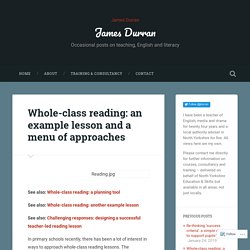

ESL English Language Learning - Adult Literacy - Listening & Reading - Audiobooks - Stories. POSERS. Free online course – The Literacy Blog. Help your child to read and write. Whole-class reading: an example lesson and a menu of approaches – James Durran. See also: Whole-class reading: a planning tool See also: Whole-class reading: another example lesson See also: Challenging responses: designing a successful teacher-led reading lesson In primary schools recently, there has been a lot of interest in ways to approach whole-class reading lessons.

The imperative to raise standards in reading is leading many to question the dominance of small group guided reading, in which – at any one time – most pupils are not being taught by the ‘expert’ in the room. Teaching the whole class instead means that all pupils can read with the teacher more often, moving faster through more or longer texts and benefiting from the teacher’s expert explanations, modelling, questioning and feedback. Of course, there can be anxieties around whole class reading, even as part of a ‘mixed-economy’ alongside work with small groups. One is around differentiation and catering for the needs of a mixed-attainment class. Reading comprehension strategies. Reading comprehension strategies focus on the learners’ understanding of written text.

Pupils are taught a range of techniques which enable them to comprehend the meaning of what they read. These can include: inferring meaning from context; summarising or identifying key points; using graphic or semantic organisers; developing questioning strategies; and monitoring their own comprehension and identifying difficulties themselves (see also Metacognition and self-regulation). How effective is it? On average, reading comprehension approaches deliver an additional six months’ progress. Repeated Reading (RR) for Fluency and Comprehension – ELT Research Bites. It is a common assumption that language proficiency translates to reading fluency, the ability to decode and comprehend text at the same time. However, research suggests that this may be untrue. Therefore, it is important to develop reading fluency alongside language proficiency.
One reason this is important is that, by improving one’s ability to decode (that is, recognize and understand familiar words) leaves more cognitive resources for higher-order comprehension skills. This idea, the basis for repeated reading (RR), is rooted in Automaticity Theory. Gorsuch and Taguchi’s (2008) research on Repeated Reading in a EFL context shows that it leads to increased comprehension. RR has been a successful tool in L1 reading contexts, especially when RR is assisted with audio recordings. The Study Gorsuch and Taguchi conducted an 11-week quasi-experimental study with 24 Vietnamese university students in Vietnam, divided into experimental groups and control groups.
The Results Discussion Reference. EEF Blog: Whole-class reading - choose your strategy carefully if you don’t want to miss the mark. In this blog, Robbie Coleman – a secondary school English teacher and a Senior Associate at the EEF – surveys the research on whole-class reading and draws two important lessons for teachers wanting to know which strategy works best...

Sometimes it’s worth repeating the obvious, just in case anyone missed it. Such as, everyone should watch The Wire, Scottish hopes of footballing success are rarely fulfilled... and Tim Shanahan’s website is one of the best sources of information about literacy on the internet. Shanahan is Professor Emeritus at the University of Illinois at Chicago, and has led the US Government’s National Reading Panel.
Recently on his blog, he fielded a question about the effectiveness of whole-class reading approaches, where one student reads aloud while their classmates follow the text. Avoiding 'straw men' Dr. Louisa Moats - Teaching Teachers to Teach Reading. 'Why whole-class reading beats a carousel – and seven ways to ensure it is successful' Each time we open a book with children it is an opportunity to walk into a new world together, to explore the inner workings of great literary minds and, as their guide, to point out to the children the sights and sounds that could so easily be missed by the untrained eye.

These reading journeys are by far the most enjoyable aspect of my day as a primary teacher. Reading Conferences With Students Within the 45 Minute English Class; Yes, It’s Possible. Confession time; I am terrible at conferring with my students.

This once proud foundation of my elementary classroom is now a crumbling pillar in my 7th grade English class. Call it a victim of the 45 minute I have to teach everything in. A victim of the so much to do. A victim of not quite knowing how to make it productive. Whatever it is, the conferring that I know I should be doing has simply not been getting done. Yet a few weeks ago, I realized that the one thing I needed the most (besides more time, more books, more knowledge) was the simple conference. So what has worked and what have I discovered? Guided reading – whole class or guided groups? How To Revolutionise Guided Reading. Literacy educator, Literacy Professor, Literacy and Reading Blog, Reading Instruction. How to Switch to Whole-Class Guided Reading – Solomon Kingsnorth. PART 1: Teacher reads to class, modelling expression and inference This is absolutely crucial.

You are the magic carpet. As you begin to read, the children are transported to the scene — every detail of the setting, every nuance in the dialogue is amplified and made real in their minds. Once you have dropped them off in the thick of the action, they can slowly begin to take the reins. Activity (a) As you read, get the children to hoover up every last piece of new vocabulary. Which other words have the same prefix? Activity (b) 60 second retrieval quiz.
PART 2: Children begin to take over. Get individual children to take over the reading out loud. “Tariq, read that line again, but this time really convince us that your life is on the line.” Activity (c) Quick-fire round of ‘Find and Copy’. “Find and copy one word from the 3rd paragraph which tells us that Maria is beginning to have second thoughts about her decision to follow Jim into the woods.” PART 3: Children read independently. FAQs.